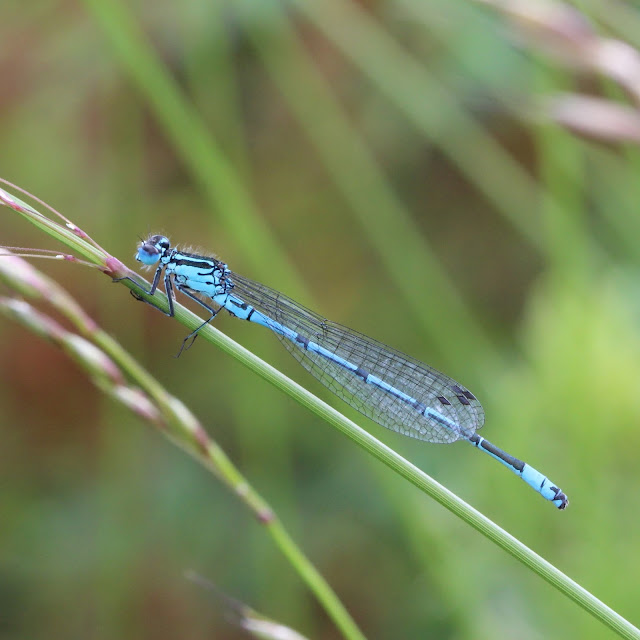I noticed this bird feeder was empty but when I went to collect it for refilling there was a small furry body sitting at its base.
It was the middle of the afternoon and the wood mouse was completely unconcerned by my presence. I went back for the camera and it just carried on feeding.
The photos were taken from 1.2m away - the closest focus of my 200mm lens. Every minute or so it went back into the hedge but then came straight back again while I was standing there.
I have noticed that the feeder gets completely emptied every day. I had assumed it was just because of the large numbers of young starlings and sparrows but they were obviously getting a helping hand.
My Blog List
Thursday, 29 June 2017
Tuesday, 27 June 2017
The full spectrum
Banks' Pond has been a regular haunt of mine for the past couple of weeks. There has been plenty to see in all the colours of the rainbow.
Sunday, 25 June 2017
Bee of the week - Yellow-face bee
This tiny bee is not quite 5mm long and is easily overlooked. It is the common yellow-face bee (Hylaeus communis). These photos are all of females on Phacelia in the garden.
Hylaeus bees are solitary and share the most unusual characteristic of carrying pollen back to their nest holes in their crop rather than on a pollen brush (scopa) on the legs or abdomen. These bees can be seen "eating" blue pollen from the anthers of Phacelia. While I was watching they were landing on the flowers and then climbing up the filaments to reach the pollen.
Hylaeus bees nest in small holes in wood, woody stems, etc and I have seen them in my bee house, although I didn't manage a photo. There are 12 Hylaeus species listed Steven Falk's Field Guide to the Bees of Great Britain and Ireland but most are localised or rare.
Friday, 23 June 2017
Perfect camouflage
Very hard to spot, unless it moves or sings, this is the common green grasshopper (Omocestus viridulus). If it knows you are watching it sits very still.
Wednesday, 21 June 2017
It's A Knockout
Considering the number of birds in the garden I get few bird strikes on the windows and very few that are fatal. I found this poor song thrush on the lawn by a window while I was mowing and was able to keep an eye on it to protect it from magpies while it recovered. It flew off after 20 minutes or so, apparently none the worse for wear.
If you are not from the UK the title of this post was the name of a not very good TV programme many years ago.
Tuesday, 20 June 2017
Allowed out on his own
There comes a time in life when you are allowed out on your own for the first time. I met this youngster out and about early in the morning with no sign of its mother. It was busy exploring and looking for something to eat. Not a close photo and not very sharp but probably worth a look.
Monday, 19 June 2017
An audience with the emperor
I went back to Banks' Pond on Saturday, hoping to see an emperor dragonfly (Anax imperator) for the first time this year. There were several flying but they were resting for only a second or two and too far away, making it very difficult to get a photo. These were about the best I could manage.
While there I had the pleasure of meeting John Atkinson, the Sedgedunum Warbler. As it was hot and the dragonflies weren't settling we gave up and I planned to return the next day.
Although I got there early yesterday, it was already hot and the emperors were on the wing when I arrived. However, even they get tired and at last a few settled (briefly) within range of the camera.
Emperors eat other dragonflies and damselflies so this male azure damselfly was really chancing his luck.
I saw only one female ovipositing out in the middle of the pond, rather out of range of my lens.
As I left I came across this slightly battered individual. He has obviously been in the wars, with damage to both front wings. Life for a male emperor dragonfly is short and intense, mostly fighting off rivals and chasing females.
Subscribe to:
Comments (Atom)



















































